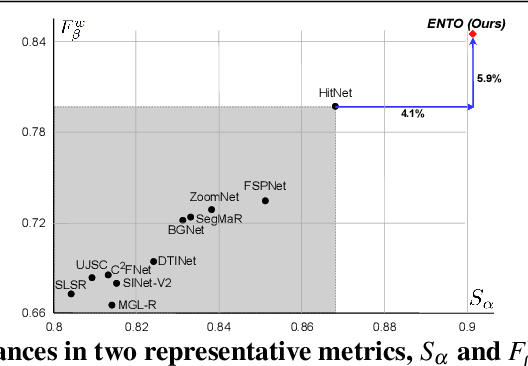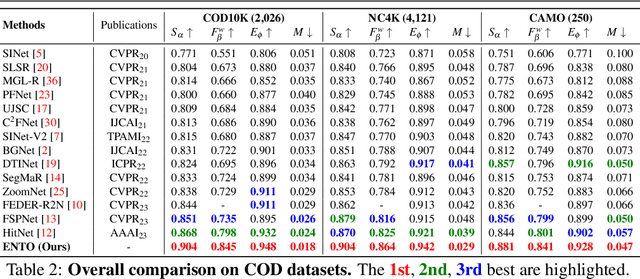Hyung-Sin Kim
AI Should Sense Better, Not Just Scale Bigger: Adaptive Sensing as a Paradigm Shift
Jul 10, 2025Abstract:Current AI advances largely rely on scaling neural models and expanding training datasets to achieve generalization and robustness. Despite notable successes, this paradigm incurs significant environmental, economic, and ethical costs, limiting sustainability and equitable access. Inspired by biological sensory systems, where adaptation occurs dynamically at the input (e.g., adjusting pupil size, refocusing vision)--we advocate for adaptive sensing as a necessary and foundational shift. Adaptive sensing proactively modulates sensor parameters (e.g., exposure, sensitivity, multimodal configurations) at the input level, significantly mitigating covariate shifts and improving efficiency. Empirical evidence from recent studies demonstrates that adaptive sensing enables small models (e.g., EfficientNet-B0) to surpass substantially larger models (e.g., OpenCLIP-H) trained with significantly more data and compute. We (i) outline a roadmap for broadly integrating adaptive sensing into real-world applications spanning humanoid, healthcare, autonomous systems, agriculture, and environmental monitoring, (ii) critically assess technical and ethical integration challenges, and (iii) propose targeted research directions, such as standardized benchmarks, real-time adaptive algorithms, multimodal integration, and privacy-preserving methods. Collectively, these efforts aim to transition the AI community toward sustainable, robust, and equitable artificial intelligence systems.
Frequency Composition for Compressed and Domain-Adaptive Neural Networks
May 27, 2025Abstract:Modern on-device neural network applications must operate under resource constraints while adapting to unpredictable domain shifts. However, this combined challenge-model compression and domain adaptation-remains largely unaddressed, as prior work has tackled each issue in isolation: compressed networks prioritize efficiency within a fixed domain, whereas large, capable models focus on handling domain shifts. In this work, we propose CoDA, a frequency composition-based framework that unifies compression and domain adaptation. During training, CoDA employs quantization-aware training (QAT) with low-frequency components, enabling a compressed model to selectively learn robust, generalizable features. At test time, it refines the compact model in a source-free manner (i.e., test-time adaptation, TTA), leveraging the full-frequency information from incoming data to adapt to target domains while treating high-frequency components as domain-specific cues. LFC are aligned with the trained distribution, while HFC unique to the target distribution are solely utilized for batch normalization. CoDA can be integrated synergistically into existing QAT and TTA methods. CoDA is evaluated on widely used domain-shift benchmarks, including CIFAR10-C and ImageNet-C, across various model architectures. With significant compression, it achieves accuracy improvements of 7.96%p on CIFAR10-C and 5.37%p on ImageNet-C over the full-precision TTA baseline.
The Others: Naturally Isolating Out-of-Distribution Samples for Robust Open-Set Semi-Supervised Learning
Apr 17, 2025Abstract:Open-Set Semi-Supervised Learning (OSSL) tackles the practical challenge of learning from unlabeled data that may include both in-distribution (ID) and unknown out-of-distribution (OOD) classes. However, existing OSSL methods form suboptimal feature spaces by either excluding OOD samples, interfering with them, or overtrusting their information during training. In this work, we introduce MagMatch, a novel framework that naturally isolates OOD samples through a prototype-based contrastive learning paradigm. Unlike conventional methods, MagMatch does not assign any prototypes to OOD samples; instead, it selectively aligns ID samples with class prototypes using an ID-Selective Magnetic (ISM) module, while allowing OOD samples - the "others" - to remain unaligned in the feature space. To support this process, we propose Selective Magnetic Alignment (SMA) loss for unlabeled data, which dynamically adjusts alignment based on sample confidence. Extensive experiments on diverse datasets demonstrate that MagMatch significantly outperforms existing methods in both closed-set classification accuracy and OOD detection AUROC, especially in generalizing to unseen OOD data.
A Revisit to the Decoder for Camouflaged Object Detection
Mar 18, 2025



Abstract:Camouflaged object detection (COD) aims to generate a fine-grained segmentation map of camouflaged objects hidden in their background. Due to the hidden nature of camouflaged objects, it is essential for the decoder to be tailored to effectively extract proper features of camouflaged objects and extra-carefully generate their complex boundaries. In this paper, we propose a novel architecture that augments the prevalent decoding strategy in COD with Enrich Decoder and Retouch Decoder, which help to generate a fine-grained segmentation map. Specifically, the Enrich Decoder amplifies the channels of features that are important for COD using channel-wise attention. Retouch Decoder further refines the segmentation maps by spatially attending to important pixels, such as the boundary regions. With extensive experiments, we demonstrate that ENTO shows superior performance using various encoders, with the two novel components playing their unique roles that are mutually complementary.
* Published in BMVC 2024, 13 pages, 7 figures (Appendix: 5 pages, 2 figures)
ConcreTizer: Model Inversion Attack via Occupancy Classification and Dispersion Control for 3D Point Cloud Restoration
Mar 10, 2025Abstract:The growing use of 3D point cloud data in autonomous vehicles (AVs) has raised serious privacy concerns, particularly due to the sensitive information that can be extracted from 3D data. While model inversion attacks have been widely studied in the context of 2D data, their application to 3D point clouds remains largely unexplored. To fill this gap, we present the first in-depth study of model inversion attacks aimed at restoring 3D point cloud scenes. Our analysis reveals the unique challenges, the inherent sparsity of 3D point clouds and the ambiguity between empty and non-empty voxels after voxelization, which are further exacerbated by the dispersion of non-empty voxels across feature extractor layers. To address these challenges, we introduce ConcreTizer, a simple yet effective model inversion attack designed specifically for voxel-based 3D point cloud data. ConcreTizer incorporates Voxel Occupancy Classification to distinguish between empty and non-empty voxels and Dispersion-Controlled Supervision to mitigate non-empty voxel dispersion. Extensive experiments on widely used 3D feature extractors and benchmark datasets, such as KITTI and Waymo, demonstrate that ConcreTizer concretely restores the original 3D point cloud scene from disrupted 3D feature data. Our findings highlight both the vulnerability of 3D data to inversion attacks and the urgent need for robust defense strategies.
Adaptive Camera Sensor for Vision Models
Mar 04, 2025



Abstract:Domain shift remains a persistent challenge in deep-learning-based computer vision, often requiring extensive model modifications or large labeled datasets to address. Inspired by human visual perception, which adjusts input quality through corrective lenses rather than over-training the brain, we propose Lens, a novel camera sensor control method that enhances model performance by capturing high-quality images from the model's perspective rather than relying on traditional human-centric sensor control. Lens is lightweight and adapts sensor parameters to specific models and scenes in real-time. At its core, Lens utilizes VisiT, a training-free, model-specific quality indicator that evaluates individual unlabeled samples at test time using confidence scores without additional adaptation costs. To validate Lens, we introduce ImageNet-ES Diverse, a new benchmark dataset capturing natural perturbations from varying sensor and lighting conditions. Extensive experiments on both ImageNet-ES and our new ImageNet-ES Diverse show that Lens significantly improves model accuracy across various baseline schemes for sensor control and model modification while maintaining low latency in image captures. Lens effectively compensates for large model size differences and integrates synergistically with model improvement techniques. Our code and dataset are available at github.com/Edw2n/Lens.git.
Effective Heterogeneous Federated Learning via Efficient Hypernetwork-based Weight Generation
Jul 03, 2024Abstract:While federated learning leverages distributed client resources, it faces challenges due to heterogeneous client capabilities. This necessitates allocating models suited to clients' resources and careful parameter aggregation to accommodate this heterogeneity. We propose HypeMeFed, a novel federated learning framework for supporting client heterogeneity by combining a multi-exit network architecture with hypernetwork-based model weight generation. This approach aligns the feature spaces of heterogeneous model layers and resolves per-layer information disparity during weight aggregation. To practically realize HypeMeFed, we also propose a low-rank factorization approach to minimize computation and memory overhead associated with hypernetworks. Our evaluations on a real-world heterogeneous device testbed indicate that HypeMeFed enhances accuracy by 5.12% over FedAvg, reduces the hypernetwork memory requirements by 98.22%, and accelerates its operations by 1.86 times compared to a naive hypernetwork approach. These results demonstrate HypeMeFed's effectiveness in leveraging and engaging heterogeneous clients for federated learning.
Unexplored Faces of Robustness and Out-of-Distribution: Covariate Shifts in Environment and Sensor Domains
Apr 25, 2024



Abstract:Computer vision applications predict on digital images acquired by a camera from physical scenes through light. However, conventional robustness benchmarks rely on perturbations in digitized images, diverging from distribution shifts occurring in the image acquisition process. To bridge this gap, we introduce a new distribution shift dataset, ImageNet-ES, comprising variations in environmental and camera sensor factors by directly capturing 202k images with a real camera in a controllable testbed. With the new dataset, we evaluate out-of-distribution (OOD) detection and model robustness. We find that existing OOD detection methods do not cope with the covariate shifts in ImageNet-ES, implying that the definition and detection of OOD should be revisited to embrace real-world distribution shifts. We also observe that the model becomes more robust in both ImageNet-C and -ES by learning environment and sensor variations in addition to existing digital augmentations. Lastly, our results suggest that effective shift mitigation via camera sensor control can significantly improve performance without increasing model size. With these findings, our benchmark may aid future research on robustness, OOD, and camera sensor control for computer vision. Our code and dataset are available at https://github.com/Edw2n/ImageNet-ES.
SlAction: Non-intrusive, Lightweight Obstructive Sleep Apnea Detection using Infrared Video
Sep 06, 2023Abstract:Obstructive sleep apnea (OSA) is a prevalent sleep disorder affecting approximately one billion people world-wide. The current gold standard for diagnosing OSA, Polysomnography (PSG), involves an overnight hospital stay with multiple attached sensors, leading to potential inaccuracies due to the first-night effect. To address this, we present SlAction, a non-intrusive OSA detection system for daily sleep environments using infrared videos. Recognizing that sleep videos exhibit minimal motion, this work investigates the fundamental question: "Are respiratory events adequately reflected in human motions during sleep?" Analyzing the largest sleep video dataset of 5,098 hours, we establish correlations between OSA events and human motions during sleep. Our approach uses a low frame rate (2.5 FPS), a large size (60 seconds) and step (30 seconds) for sliding window analysis to capture slow and long-term motions related to OSA. Furthermore, we utilize a lightweight deep neural network for resource-constrained devices, ensuring all video streams are processed locally without compromising privacy. Evaluations show that SlAction achieves an average F1 score of 87.6% in detecting OSA across various environments. Implementing SlAction on NVIDIA Jetson Nano enables real-time inference (~3 seconds for a 60-second video clip), highlighting its potential for early detection and personalized treatment of OSA.
UpCycling: Semi-supervised 3D Object Detection without Sharing Raw-level Unlabeled Scenes
Nov 22, 2022



Abstract:Semi-supervised Learning (SSL) has received increasing attention in autonomous driving to relieve enormous burden for 3D annotation. In this paper, we propose UpCycling, a novel SSL framework for 3D object detection with zero additional raw-level point cloud: learning from unlabeled de-identified intermediate features (i.e., smashed data) for privacy preservation. The intermediate features do not require additional computation on autonomous vehicles since they are naturally produced by the inference pipeline. However, augmenting 3D scenes at a feature level turns out to be a critical issue: applying the augmentation methods in the latest semi-supervised 3D object detectors distorts intermediate features, which causes the pseudo-labels to suffer from significant noise. To solve the distortion problem while achieving highly effective SSL, we introduce hybrid pseudo labels, feature-level Ground Truth sampling (F-GT) and Rotation (F-RoT), which safely augment unlabeled multi-type 3D scene features and provide high-quality supervision. We implement UpCycling on two representative 3D object detection models, SECOND-IoU and PV-RCNN, and perform experiments on widely-used datasets (Waymo, KITTI, and Lyft). While preserving privacy with zero raw-point scene, UpCycling significantly outperforms the state-of-the-art SSL methods that utilize raw-point scenes, in both domain adaptation and partial-label scenarios.
 Add to Chrome
Add to Chrome Add to Firefox
Add to Firefox Add to Edge
Add to Edge